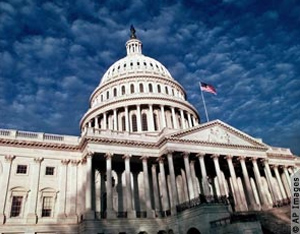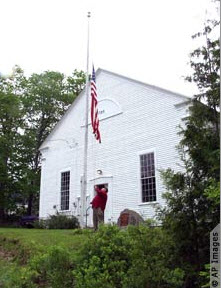2010-11-01 | Determine Control of U.S. Congress
Midterm Elections Determine Control of U.S. Congress
01 November 2010

The 112th Congress, as selected by voters November 2, is scheduled to convene at the U.S. Capitol in January 2011. (Photo: AP Image)

A selectman, an elected official, raises the American flag at the town hall in Sedgewick, Maine. The 1794 building is the Maine’s oldest town hall. (Photo: AP Image)
Washington - On November 2, Americans will cast their ballots to determine who will represent them in the 112th Congress, scheduled to convene in January 2011.
These elections, because they occur in even-numbered years at the halfway point of a presidential term, are known as midterm elections. This timing encourages pollsters and political pundits to view the outcomes as referendums on the policies of the current president, but that narrow interpretation can distract from their true importance.
In electing a new Congress every two years, American voters decide who will speak for them in crafting legislation, determining government spending and overseeing the activities of the executive branch. The Congress is the legislative branch within the three-pronged federal government. The others are the executive branch, led by the White House, and the judicial branch, headed by the Supreme Court. Each has a separate but equal role in governing the nation. As laid out in the U.S. Constitution, each branch checks and balances the powers of the others.
The U.S. Congress comprises two chambers: the Senate, to which members are elected for six-year terms; and the House of Representatives, whose members serve two-year terms. A U.S. president is limited to two terms, but there are no limits on how many terms a member of Congress may serve.
Each November of an even-numbered year, every one of the 435 House seats is filled by the will of the people, as expressed through the ballot box. Simultaneously, approximately one-third of the Senate is also elected, although that number varies from election to election because senators sometimes retire or die in the middle of their terms. In 2010, 37 senators will be elected or re-elected.
FAMILIAR CONCERNS, NEW VARIABLES
As in every U.S. election, a variety of factors affects voters' decisions. In 2010, the economy will be a major concern, as the nation and world emerge from one of the most serious financial crises since the Great Depression. Voters are worried about unemployment, home foreclosures and taxes. They also are nervous about their retirement funds and the financial burdens - both personal and public - they might pass on to their children and grandchildren.
In 2010, "Independents" - voters not affiliated with either the Democratic or the Republican Party - are a growing component of the electorate, a development that has siphoned members away from each party. A CBS Television/New York Times poll released in April reported that 42 percent of Americans now identify themselves as Independents.
The rise of the tea party movement, which advocates limited government power and reduced government spending, has drawn voters away from the mainstream Republican Party. In some cases tea party-supported candidates have defeated well-established Republican candidates in primaries.
A selectman, an elected official, raises the American flag at the town hall in Sedgewick, Maine. The 1794 building is the Maine's oldest town hall.
Another factor in 2010 races is the so-called "enthusiasm gap." Political observers say that the high interest, especially among younger voters, during the 2008 campaign that culminated in the election of Barack Obama as president is not evident in 2010, at least among Democrats. Republicans, especially the tea party element within the party, seem to be more enthusiastic about the 2010 contests.
There has been much speculation in the media about whether 2010 will be a "wave" election, one that washes away a large number of those currently serving in Congress and switches political control in one or both chambers. Recent wave elections occurred in 2006, putting the Democrats in control of the House of Representatives, and in 1994, sweeping the Republicans, led by Georgia's Newt Gingrich, into power.
Early polls suggested 2010 could be another wave, but more recent data suggest races are tightening. Two weeks before the elections, Republicans are cautiously optimistic about gaining control of the House of Representatives, but Democrats seem likely to retain control of the Senate.
Such an outcome would create a "divided" government in Washington, with one political party controlling the White House and the other controlling one or both chambers of Congress. That situation can make it more difficult to pass legislation but, conversely, can force greater compromise to break political logjams.
Americans seem very comfortable with creating divided governments, perhaps distrustful of empowering the federal government too broadly. Since 1968, only during the Jimmy Carter administration and the first two years of the Bill Clinton administration has the same party controlled the executive and legislative branches.
STATE AND LOCAL
As important as the congressional races are, they are a tiny fraction of the total number of elected posts U.S. voters will fill on Election Day.
At the state level, 37 governors will be elected, selections particularly important because in 2011 the once-in-a-decade process of redistricting the seats in the House of Representatives will occur. The governors elected in 2010 will play significant roles in determining how the boundaries of congressional districts are redrawn in light of the 2010 census data.
State legislators also will be chosen in many states on November 2, along with county executives, mayors, and city and town council members. Many jurisdictions also will elect attorneys general, treasurers, comptrollers and even judges.
The winners of these local races, although they lack the prestige and national import of congressional service, likely will have stronger effects on the day-to-day lives of their constituents as they serve out their terms, many working for small salaries or even without pay.
From emergency services like police and firefighters to the more mundane matters of trash collection and road maintenance, local governments are front lines of U.S. government and perhaps the purest expressions of American democracy.
(This is a product of the Bureau of International Information Programs, U.S. Department of State. Web site: http://www.america.gov)
- Translation:
- 中文